Why 2009 Was When Big Tech Began To Control Web 2.0
It's 2009 and Firefox is being challenged by Google’s new Chrome browser, as Microsoft IE continues its slow decline. Meanwhile, Facebook acquires trendy social software app FriendFeed.

In July 2009, RWW had 2,650,000 page views, of which nearly 1.3 million were unique visitors. Nearly half (49 percent) of visits were from Firefox users, with 25 percent using IE. Safari (12.5 percent) and Chrome (8.5 percent) were the next most popular.
That Firefox dominated our statistics in 2009 indicated that our readers were tech-savvy and likely to be open-source supporters. In the much wider home and office market, Microsoft still had nearly 70 percent web-browser market share with IE; Firefox was second, at just over 20 percent. But Firefox users were our people, and our people were the early adopters who pointed to where the market was heading. It was obvious IE was toast, if you looked at our stats and read our browser posts—which highlighted the innovations in Chrome and Firefox, and the lack thereof in IE.
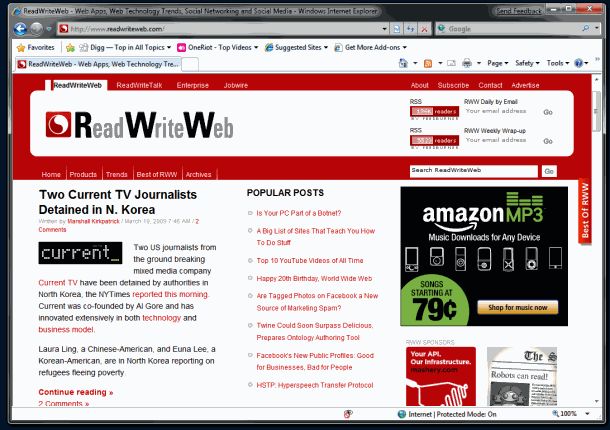
The real question was would Firefox be the next mainstream browser of choice, or would it be Google’s Chrome (released last September)? The answer to that question was becoming more obvious in 2009.
Back in March, when I had visited the Googleplex, I’d also walked over to the adjacent Mozilla headquarters—a rather drab mud-brown building that stood in stark contrast to Google’s shiny, colorful new complex. At this time, around 85 percent of Mozilla’s revenue came from Google, in exchange for Google being the default home page and search engine of Firefox. Frankly, Mozilla was under Google’s thumb, and now it had to compete against Google’s impressive new Chrome browser too.
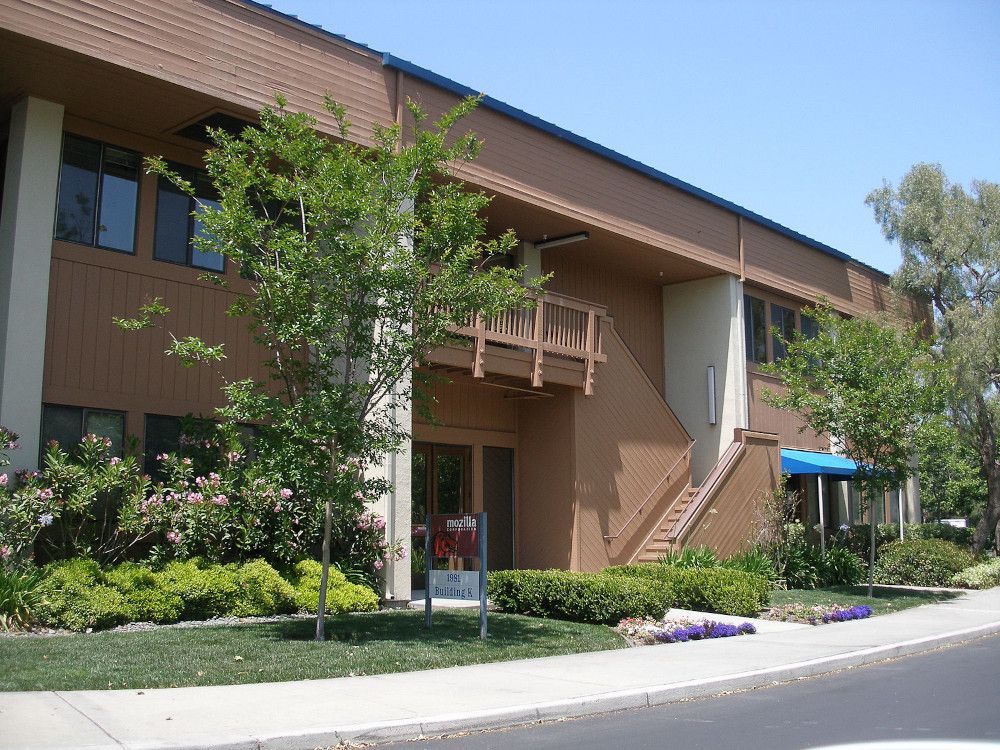
If I had to pinpoint one sign that the rose-tinted view of Web 2.0 as an open-platform paradise was about to come to an end, the emergence of Google Chrome would be it.
In a sit-down interview that day, Chris Beard, Mozilla’s chief innovation officer, visibly bristled when I suggested that Chrome performed better with heavy-duty web apps. When I cited Google’s claim that Chrome’s isolated tab processes meant a more stable browser, Beard replied that Firefox too was very stable and that it didn’t crash much these days. That he even had to mention the crashes was a giveaway, though: it was an all-too-familiar problem for Firefox users, although it had improved recently.

Regardless, for those in the know (that is, RWW readers), it was clear that Chrome was already technically superior to Firefox. Not only that, but Google had market muscle and was starting to flex it. One of our readers perceptively commented, “At the bottom of your Google-distributed RSS feed, which I read in Google Reader, this article had a huge Google AdSense ad for ‘Install Google Chrome.’”
Emergence of the Big Five
By mid-2009 it was noticeable, at least to RWW readers, that the internet winds were shifting. The big internet companies were encroaching more and more into Web 2.0—and Google in particular was positioning itself well; it was poised to take major steps in the desktop-browser market and also building an open-source smartphone OS.
Apple iOS was only third in the smartphone OS market at this point, behind Nokia’s Symbian and the Blackberry. But everyone knew Apple had the most advanced smartphone and mobile-app marketplace on the planet.
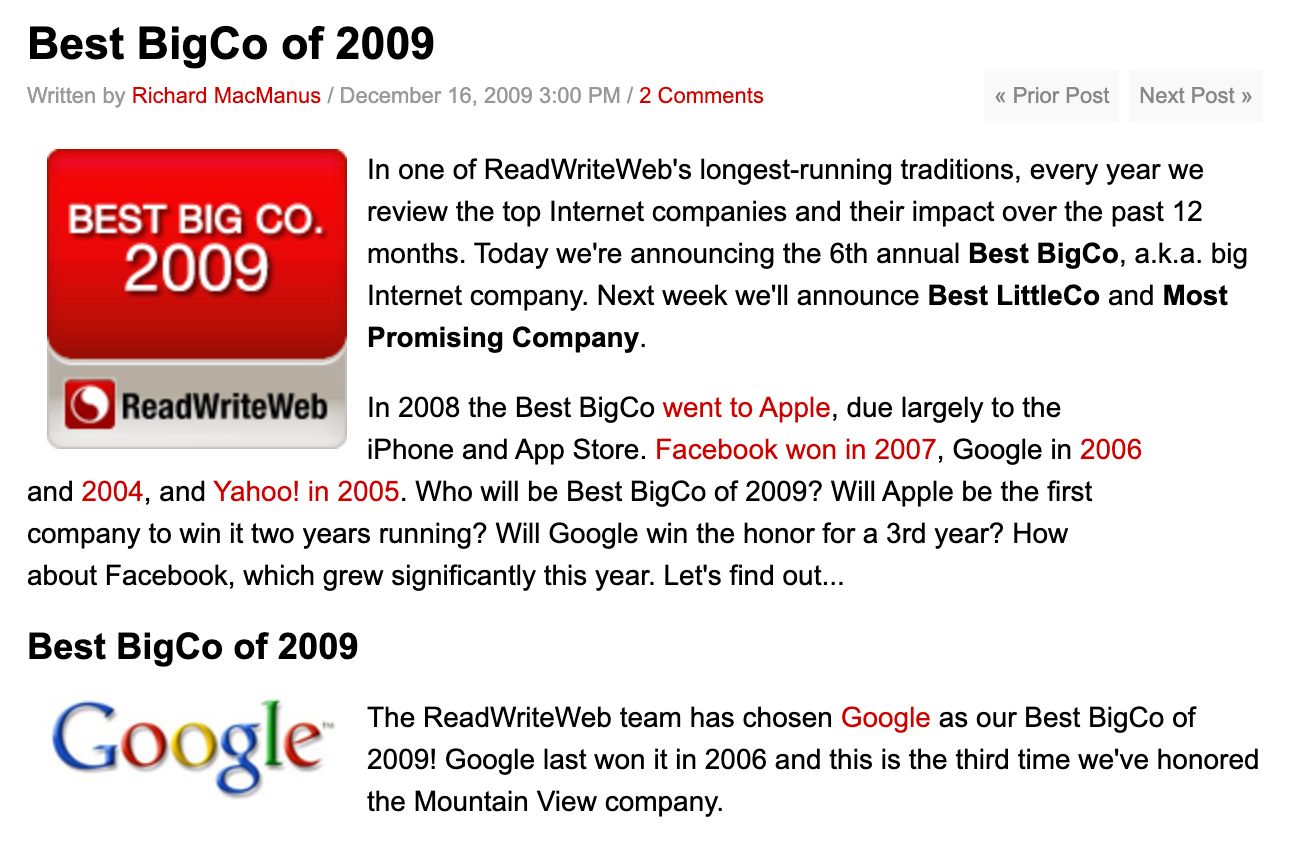
It wasn’t just at the browser or device level that internet bigcos were making their presence felt. Amazon was the early leader in the nascent cloud computing market, while Facebook was now the leading social network (it had surpassed MySpace in number of unique US visitors in May 2009).
Microsoft remained a late adopter in Web 2.0—for example, it launched a search engine called Bing in May. While taking on Google in search was almost impossible by this point, Microsoft’s war chest of Windows revenue ensured that it would continue to be a major web player.
Together, these five companies—Google, Apple, Facebook, Amazon, Microsoft—would come to dominate the internet within a decade. And it all started to coalesce for them in 2009.
Facebook Buys FriendFeed
I’d argue it was Facebook’s purchase of the trendy geek app FriendFeed in August 2009 that illustrated once and for all that big companies were in control of Web 2.0 now.
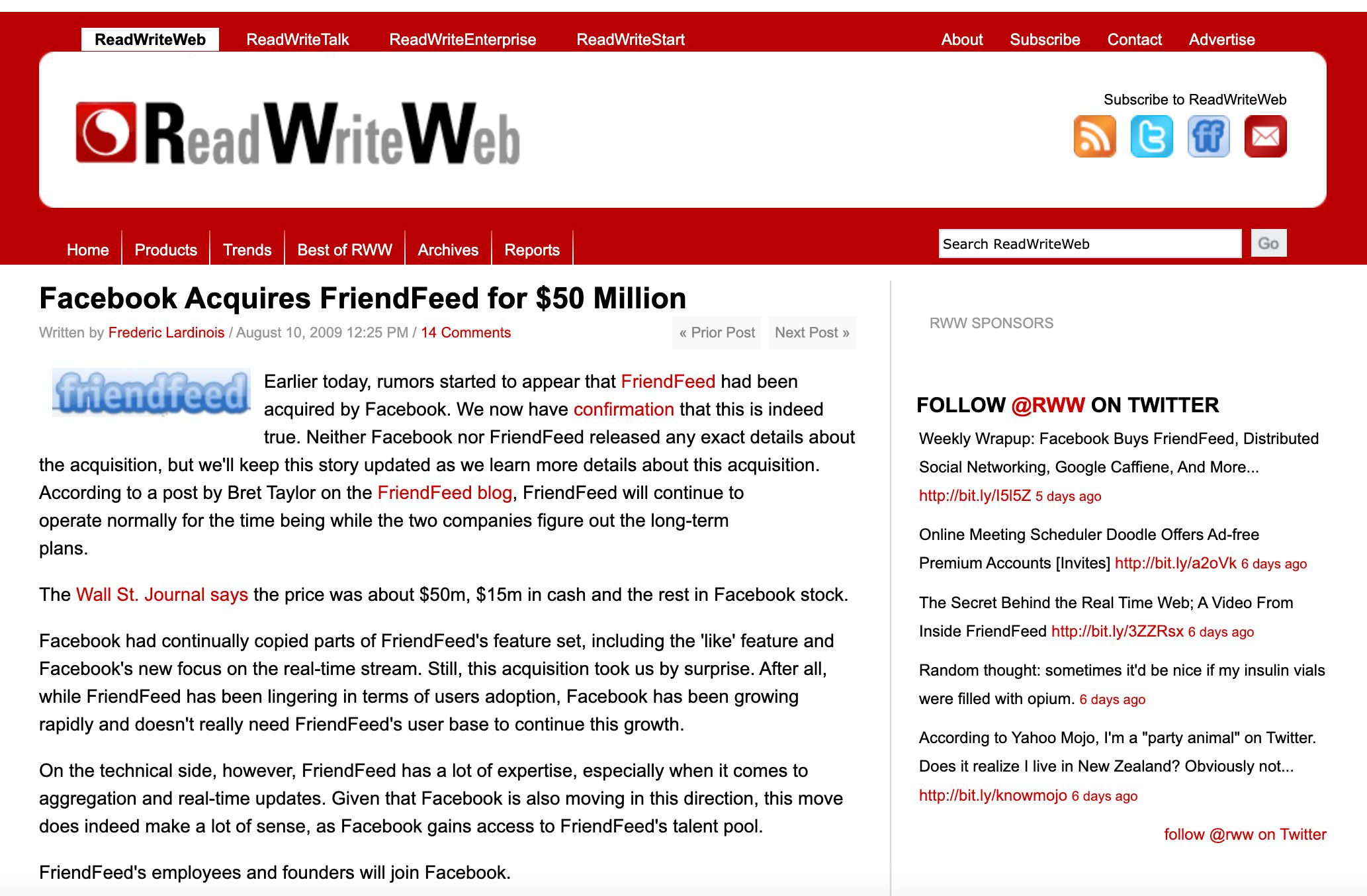
It was Facebook’s first major acquisition. In 2007 Zuckerberg’s company had acquired a “WebOS” system called Parakey, which had been developed by two Firefox engineers, and it had bought out ConnectU in 2008, but neither was a strategic product acquisition. FriendFeed had a small but avid user base along with a couple of significant product innovations that Zuckerberg coveted for his own product.
One was the Like button. While FriendFeed didn’t invent it (Flickr had a Favorite button and Digg had a Digg It button, for instance), it had much more of a social twist than the others. FriendFeed’s implementation more widely shared Likes, which helped to expand connections between users, which helped to increase “engagement”—quickly becoming the key metric of the social web. Facebook had already copied the Like button earlier in 2009, but it didn’t immediately have the subtleties of FriendFeed.
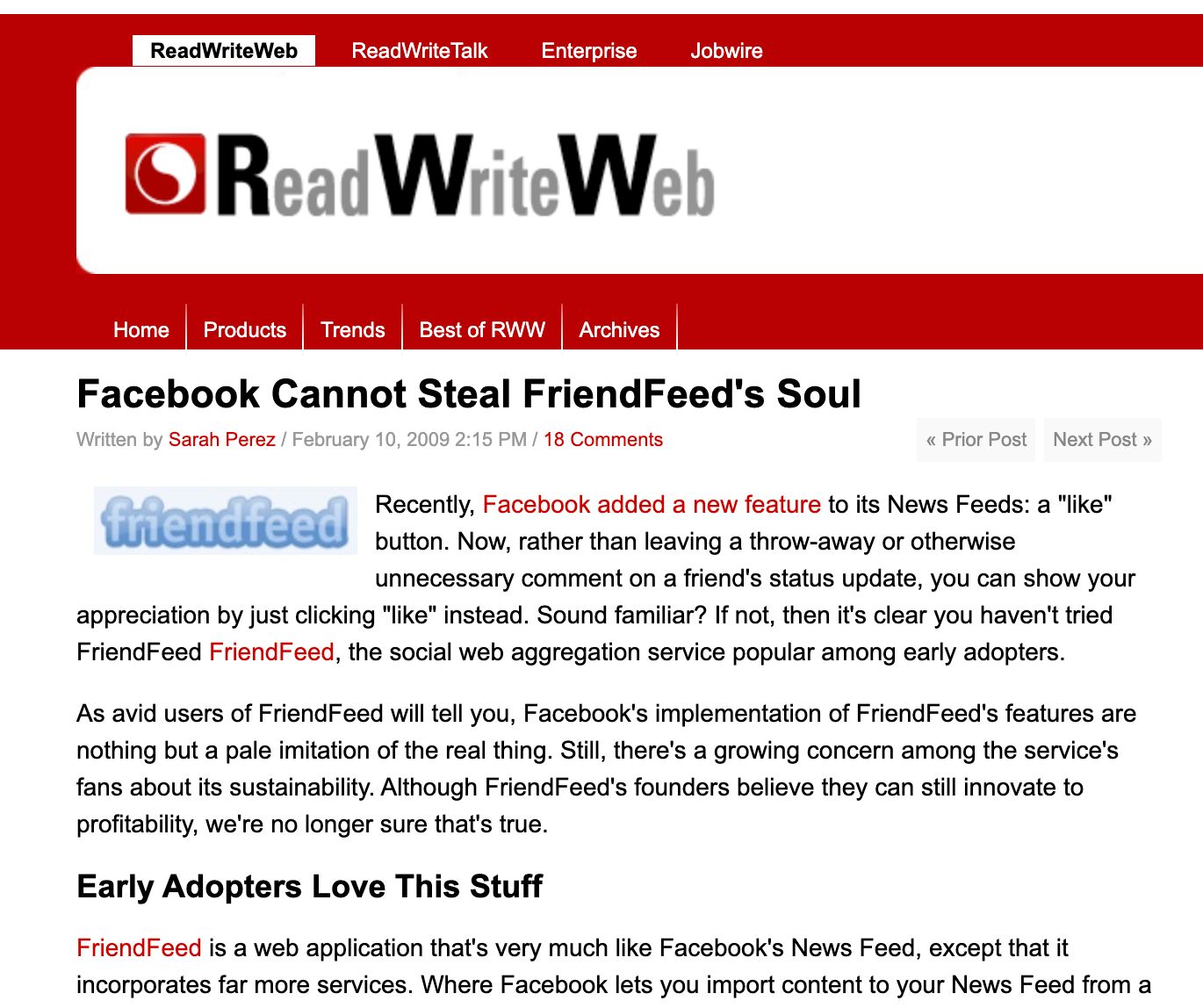
The second innovation FriendFeed had was real-time updating, which Facebook would soon incorporate into its News Feed—allowing users to see updates from their friends in real time, as they were posted.
While the acquisition would undoubtedly improve Facebook, many early adopters of FriendFeed were dismayed at the news. Bloggers especially loved FriendFeed, as it was a place on the web where they could aggregate all their blog feeds and social software activity. It also allowed them to monitor which trendy services others were using and talking about.
My own FriendFeed page automatically updated whenever I posted something on RWW, “dug” a story on Digg, uploaded a photo to Flickr, added a bookmark on del.icio.us, posted a message on Twitter, loved a song on Last.fm, and so on. I had around twenty Web 2.0 services plugged into FriendFeed, and at the time it was acquired, it was sharing fifteen posts per day (although mostly from Twitter).

But, in truth, FriendFeed wasn’t a product that was “sticky” in and of itself. I maybe visited my FriendFeed home page once or twice a day and spent a few spare minutes to like or comment on stuff. All the RWW bloggers used the product in a similar way. We had also been one of the first tech blogs to profile FriendFeed; Sean interviewed the founders in early 2008 for our ReadWriteTalk podcast. So we loved the product, and it was a fan favorite among our readers too. However, you couldn’t deny that the real action was increasingly on the likes of Facebook, Twitter, and Digg.
The sentiment among FriendFeed users about the acquisition was overwhelmingly negative. When cofounder Bret Taylor’s feed updated with the news, scores of people left comments. Many of them disliked Facebook and were angry that their beloved indie service was being gobbled up. One of the first to comment summed it up nicely: “Uh. Well, that’s the end of that.”
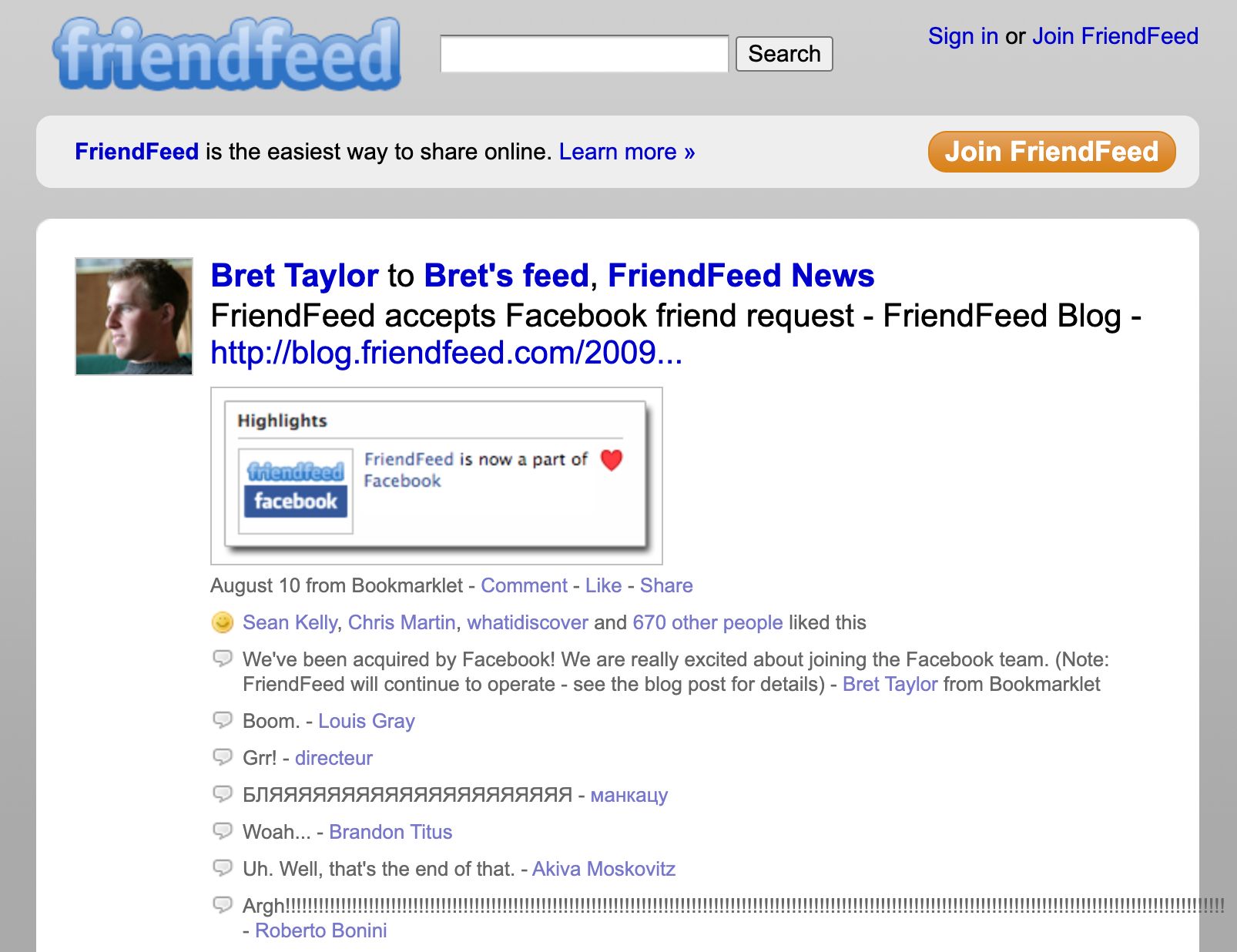
I don’t think that commenter meant it was the end of Web 2.0 entirely, but—to me, at least—it signaled the end of a certain innocence. It was unavoidable now that some companies were getting more and more powerful, at the expense of both open-source projects (like Firefox) and niche products (like FriendFeed).
This post is part of my serialized book, Bubble Blog: From Outsider to Insider in Silicon Valley's Web 2.0 Revolution. View table of contents.
Next up: 041. Planning the First ReadWriteWeb Unconference
Buy the Book
My Web 2.0 memoir, Bubble Blog: From Outsider to Insider in Silicon Valley's Web 2.0 Revolution, is now available to purchase:
- Paperback, US$19.99: Amazon; Bookshop.org
- eBook, US$9.99: Amazon Kindle Store; Apple Books; Google Play
Or search for "Bubble Blog MacManus" on your local online bookstore.